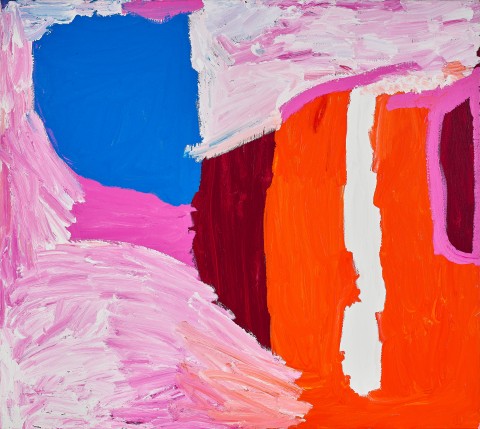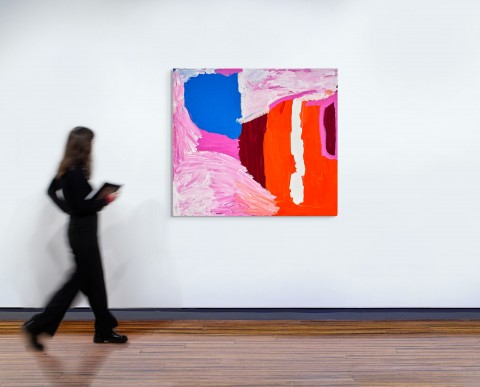Dibirdibi country, 2009
Mirdidingkingathi Juwarnda Sally Gabori
synthetic polymer paint on linen
121.5 x 136.5 cm
bears inscription verso: artist’s name, title, medium, Mornington Island Arts and Crafts cat. 3954-L-SG-0109 and Alcaston Gallery cat. AK14953
Mornington Island Arts and Crafts, Mornington Island, Queensland
Alcaston Gallery, Melbourne (stamped on stretcher bar verso)
Private collection, Melbourne, acquired from the above in December 2009
Makarrki – My Big Brother, King Alfred’s Country, Alcaston Gallery, Melbourne, 12 January – 6 February 2010 (label attached verso)
Coming to painting late in life as an octogenarian in 2005, the art of Mirdidingkingathi Juwarnda Sally Gabori stands as a profound tribute to her homeland on Bentinck Island—a small, sparsely vegetated rise in the southern Gulf of Carpentaria, where she spent the first two decades of her life. In her youth, Gabori and her community lived from the natural abundance of the surrounding ocean and estuaries, following the communal traditions of the Kaiadilt people.
In 1948, after a series of natural disasters, Gabori and the remaining inhabitants of Bentinck Island were forcibly relocated to the Presbyterian mission at Gununa on nearby Mornington Island. Although skilled in making fish traps and woven baskets, the Kaiadilt, unlike many other Aboriginal language groups, did not have a tradition of mark-making—whether on tools, objects, or bark. Taking this cultural background into account, Gabori’s artistic vision is entirely self-fashioned, drawn from the mental maps of her beloved Bentinck Island and the country she cherished. From her earliest works, Gabori painted aspects of her own country as well as those of her brother, father, and husband—depicting not only the geography of the land but also the rich sea life central to the Kaiadilt world.1
A powerful evocation of her husband’s homeland, Dibirdibi Country, 2009 depicts a subject Gabori returned to more often than any other. Here, she recalls the country of her husband, Kabarrarjingathi Bulthuku Pat Gabori, and the story of the Rock Cod Ancestor. The painting represents the mangrove swamps and saltpans of his country, as well as a small river near his birthplace—the mythic site where, in ancestral times, the liver of Dibirdibi, the Rock Cod Ancestor, was cast into the sea, creating a permanent freshwater well.2
Known for her luminous palettes and intuitively bold brushwork, Gabori layers multiple meanings into her depictions of Dibirdibi. She paints at once the physical landscape of the saltpans, the Dreaming of the Rock Cod Ancestor, a portrait of her late husband bound to his country, and, ultimately, her own profound sense of longing, loss, and remembrance.
1. Pinchbeck, C., ‘Mirdidingkingathi Juwarnda Sally Gabori’ in unDisclosed, 2nd National Indigenous Art Triennial, National Gallery of Australia, Canberra, 2012, p. 64
2. McLean, B., ‘Dulka Warngiid; The Whole World’ in Mirdidingkingathi Juwarnda Sally Gabori Dulka Warngiid: Land of All, Queensland Art Gallery I Gallery of Modern Art, Brisbane, 2016 p. 40
CRISPIN GUTTERIDGE

